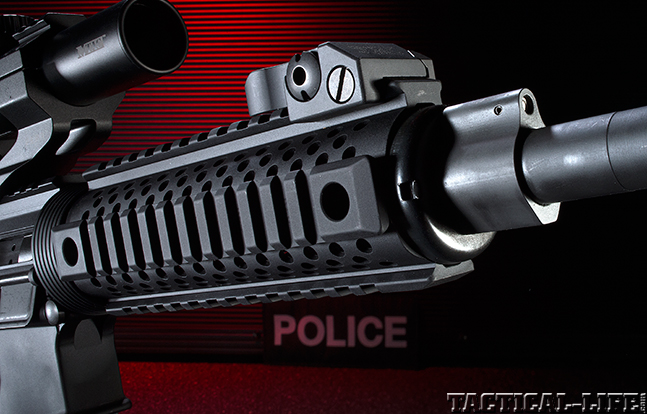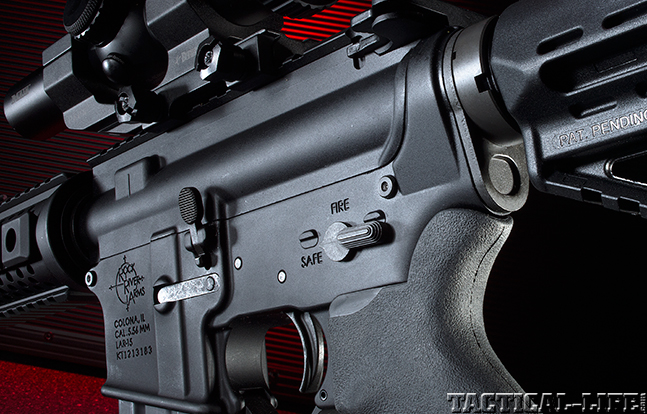When it comes down to it, officers need a simple, sturdy and reliable carbine for patrol duty—one that will be there for them when they need it and can be counted upon for every shot.
As I opened the cardboard box from Rock River Arms (RRA) with a new test rifle for me to try out, I quickly discovered the standout qualities of the firearm within. The LAR-15 Delta CAR carbine in 5.56mm NATO features the extra touches and attention to detail that bring an M4-style carbine like this to the forefront in a crowded market.
My appreciation grew as I slid the plastic case out of the cardboard box in question. The RRA LAR-15 Delta CAR came packed in a very nice flat, polymer case that is just the right length for the gun it contains, with latches made from metal rather than plastic. Things were looking up.
Advertisement — Continue Reading Below
Even though this was the first time I worked with an RRA product, I knew that the Delta CAR was going to be high quality, as most AR-15s manufactured by reputable companies are. Those manufacturers are committed to providing a high-quality product that meets or exceeds mil-spec standards. True “mil-spec,” or even theoretical mil-spec, ensures a high likelihood of purchasing a quality product because of standardization, which in the end is good for everyone. And when it comes to quality, the LAR-15 Delta CAR certainly does not disappoint.
Gun Details
As I checked out the Delta CAR I hit upon something that set it apart from the competition right out of the box. I retracted the charging handle, checked the chamber to make sure it was clear and let the carrier slide home. Then, pointing the Delta CAR in a safe direction, I pulled the trigger. I had just felt one of the best and most crisp target factory triggers on an M4 configuration carbine I have ever tried—the RRA’s two-stage trigger. It was very nice with almost no slack, just a light—but not too light for duty use—“glass rod” trigger. The military feel of standard AR triggers was totally absent. There it was; I was hooked.
Advertisement — Continue Reading Below
The Delta CAR is very nicely setup, with an eye toward mounting AR-specific optics for operation over the entire effective range of the 5.56mm cartridge. What makes the Delta CAR well suited for higher-powered optics with larger objectives is its low-profile gas block, which eliminates the traditional military front sight tower. The upper receiver rail connects seamlessly with that of the handguard, forming one long top rail from the gas block back to the charging handle. Backup iron sights are not included with the Delta CAR.
While my test gun has the gas block set in the traditional M4 Carbine location, RRA also has a fraternal twin to the Delta CAR, the Delta Mid-Length, that features a mid-length, low-profile gas block setup. The Mid-Length version has a longer forend than the Delta CAR, which is needed to protect the longer gas tube. Mid-length-ported M4s cycle less abruptly than carbine-length-ported M4s. They combine the advantages of the smoother-shooting full-size AR-15 rifle with the compactness of an M4 Carbine. The only disadvantage (at least theoretically) of any mid-length gas system is that there is no mil-spec standard for the length of the gas tube or the exact position of the gas port. This could be a minor problem if the gas system tube is ever damaged and needs to be replaced. The carbine-length Delta CAR weighs 7 pounds unloaded, while the Mid-Length version weighs 7.3 pounds unloaded due to the longer forend.
Both Delta versions utilize 16-inch, chrome-moly, heavy barrels with 1-in-9-inch twist rates. The heavier barrel profile provides more stiffness for potentially increased accuracy over the military’s M4-contour barrels. The barrel is capped with a removable A2 flash suppressor on 1/2×28 threads.
Advertisement — Continue Reading Below
For the lower receiver, RRA offers several grip options. My test sample came with an Ergo SureGrip rather than the standard A2 grip. The SureGrip provides three advantages over the standard military grip: It is made of rubber and gives a tackier feel, it fills the hand better, and it contains a small storage compartment. RRA’s Delta CAR buttstock, riding on a buffer tube that offers six length-of-pull positions, is nothing short of excellent. The stock’s release is in the center, not on the bottom, which prevents accidental repositioning of the stock since it can’t be bumped like the GI stock can. There is a Picatinny rail on the bottom to mount additional accessories. An ambidextrous quick-detach (QD) sling attachment port is located near the butt of the stock.
Since I am “written directions” challenged (it’s not that I don’t understand them, I just don’t like to read them), I made a final discovery about the Delta CAR stock through actual use. It has a very low-profile, watertight battery storage compartment that is part of the lower stock frame. Until you actually look at the butt end of the stock itself (or read the directions), you won’t realize it’s there.
The Delta CAR is marvelously well balanced and executed. For me, an entry or patrol carbine needs to snap in and out of position, naturally locking on target. The Delta CAR does just that.
Advertisement — Continue Reading Below
Range Time
I had set our department qualification to run in November, which happened to coincide with the delivery of the Delta CAR, so I used it for our course, which is 40 rounds. The State of Ohio mandates a mere 20-round annual rifle course, but I added additional segments for our agency.
For the qualification, I mounted an older Aimpoint Comp 2 red-dot sight. Yes, the Comp 2 is larger than the new micro red-dot sights, but when mounted on a flattop receiver it does not require a riser to bring it up to eye level. I prefer the simple red dot over more complex reticles for CQB because there are fewer decisions in front of my eyes to confuse my brain. With the basic Aimpoint, you put the red dot on the target and pull the trigger. The only other thing I added to the Delta CAR was a Tactical Link QD sling.
Advertisement — Continue Reading Below
I ran the Delta CAR without a pre-shooting field-strip or additional lubrication. I ran the course using a mixture of Winchester 55-grain “white box” FMJ and Hornady 55-grain TAP ammo. The rounds, interspersed between two magazines, ran flawlessly. Between the ergonomics of the Delta CAR and the Aimpoint sight, I attained a 100-percent passing score. The carbine’s long-range accuracy was right on at the 100-yard-line phase, which is fired from a standing unsupported position. The Delta CAR’s natural pointability, combined with its excellent trigger, allowed me to drop my rounds on target with little effort.
I conducted chronograph work a couple of weeks later, using a Montie Gear Lightweight AR Rest to assist in the evaluation. Velocity testing yielded some interesting results. The speed and kinetic energy champ was the Federal American Eagle 62-grain XM855 green-tip, boat-tail ball ammo, which raced over the chronograph at an average velocity of 2,951 feet per second (fps). Out of a 16-inch barrel, that is moving. The lighter 55-grain, .223 Federal Premium Hi-Shok TRU soft-point load averaged 2,855 fps. This illustrates the difference between a true 5.56mm NATO load and a .223. Even with 7 more grains of bullet weight, the XM855 ammo smoked the lighter-weight TRU load by 100 fps, resulting in the highest kinetic energy delivered on target by the test loads. Again, not a single malfunction occurred, and the Rock River Delta CAR was never cleaned or lubed.
The Delta CAR is fine weapon that excels as a patrol carbine or entry weapon. If I was looking for a “do it all” AR for LE duty, this would certainly be at the top of my list, especially because of its “married guy” pricing.
Advertisement — Continue Reading Below































